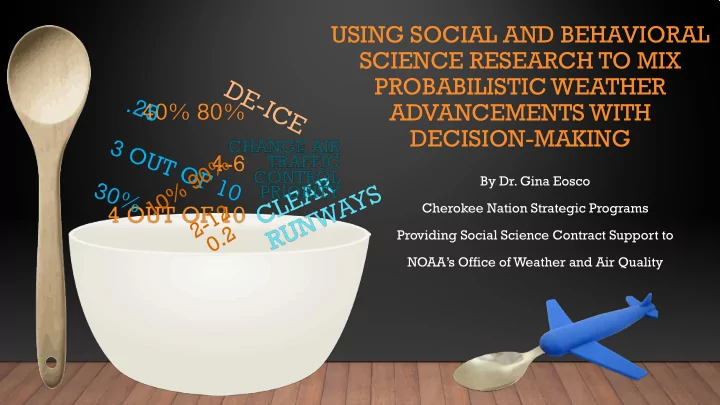

USING SOCIAL AND BEHAVIORAL SCIENCE RESEARCH TO MIX PROBABILISTIC WEATHER ADVANCEMENTS WITH DECISION-MAKING By Dr. Gina Eosco Cherokee Nation Strategic Programs Providing Social Science Contract Support to NOAA’s Office of Weather and Air Quality
EXAMPLE OF THE FORECAST PROCESS People http://www.iaas.uni- stuttgart.de/forschung/projects/simtech/sim- workflows.php
A RISK INFORMATION SEEKING AND PROCESSING MODEL Griffin, R. J., Dunwoody, S., & Neuwirth, K. (1999). Proposed model of the relationship of risk information seeking and processing to the development of preventive behaviors. Environmental research, 80(2), S230-S245. http://file.scirp.org/Html/4- 2250052_38377.htm
POINT #1: PEOPLE DON’T NATURALLY KNOW THEIR PROBABILITY THRESHOLD • “Can’t the emergency manager just give us their probability threshold? I mean, don‘t they have a database of past snow storms with how much it costs? Can’t they figure out their threshold from that?” ~A forecaster about emergency managers
POINT #2: PROBABILITIES PLUS CONTEXT CAN CREATE USEFUL INFORMATION • A New England DOT official said, “Timing, timing, timing. We want to know what to expect, when we will have plows on the road, when will we need to contact schools . ” Partners stressed that all decisions depend on the time of day. In fact, a North Carolina DOT representative said, “Whether it’s 4, 7, or 10 inches, we deal with it the same way. It’s about the timing.”
POINT 3: LET YOUR STAKEHOLDERS DRIVE YOUR PROBABILISTIC INNOVATION • Partners watch for changes from one model run to another. If the models are consistent, partners perceive this as high confidence. If models diverge from run to run, partners perceive this as low confidence. • This lead to brainstorming with Dr. James Correia (@jimmyC42). How can we use model to model probabilistic output to convey confidence?
POINT #4: LET STAKEHOLDERS DRIVE THE NEXT RESEARCH QUESTION • Aviation needs: predicting the location and timing of narrow snow bands • Airport representatives in the study said increased lead time for snow bands would help reduce the impact on the aviation industry. With some research, our weather probabilities could do this! Reprioritize air traffic 60% chance … in the …with rapid control for snow band next 40-60 accumulation key will occur… minutes connecting flights
Thank you for listening! Dr. Gina Eosco Gina.Eosco@noaa.gov Cherokee Nation Strategic Programs Providing Social Science Contract Support to NOAA’s Office of Weather and Air Quality
Recommend
More recommend